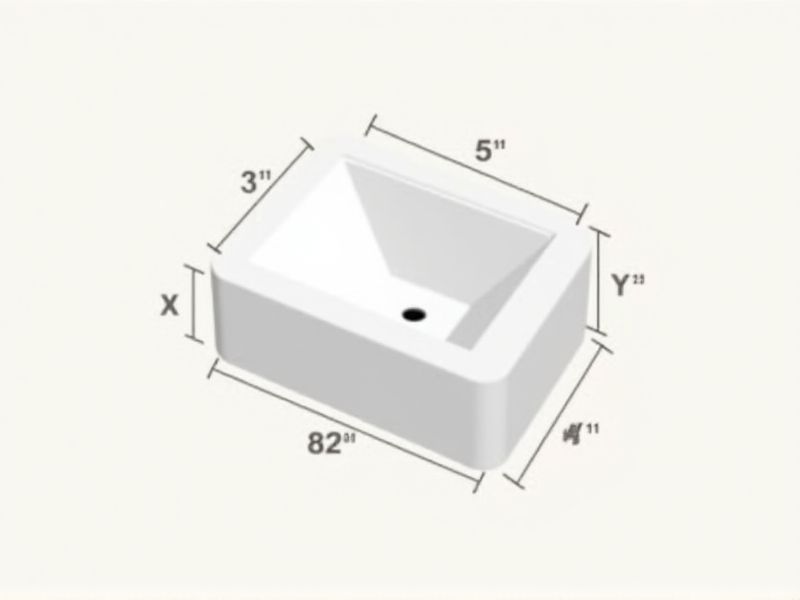
When selecting a vessel sink, knowing the standard dimensions can help ensure the best fit for your countertop and bathroom. Most vessel sinks typically measure between 16 to 20 inches in diameter, with oval or rectangular versions ranging from 18 to 23 inches in length. The standard height usually falls between 4 to 7 inches, allowing for comfortable use while maintaining a stylish above-counter look. Always double-check your available space and faucet height before purchasing to guarantee easy installation and optimal functionality.
Width Of Vessel Sink
When selecting a vessel sink, the standard width typically ranges from 16 to 24 inches, providing ample space for functionality and design. A width of 18 inches is common for smaller bathrooms, while larger sinks, around 24 inches, are suitable for master bathrooms or expansive vanities. The width directly impacts your bathroom's aesthetic and usability, allowing for various styles from sleek modern designs to more ornate, traditional patterns. Always consider your countertop space, ensuring at least 6 inches of clearance on each side for optimal installation and user comfort.
Height Of Vessel Sink
The height of a vessel sink typically ranges between 4 to 6 inches, making it a stylish choice for contemporary bathrooms. This measurement is crucial for ensuring user comfort and accessibility, especially for individuals tall 5'8" and above. Selecting a height that aligns with your countertop, preferably 30 to 36 inches, enhances functionality while maintaining aesthetic appeal. You should also consider the total height after installation, which may affect usability and the overall design of your bathroom space.
Depth Of Vessel Basin
The depth of a vessel sink basin typically ranges from 5 to 10 inches, impacting both functionality and design appeal. A deeper basin, around 8-10 inches, offers enhanced usability, preventing water splashes and accommodating larger items. Conversely, shallower models, usually 5-7 inches, create a contemporary aesthetic but may require more caution during use. Understanding these dimensions is essential for selecting a vessel sink that suits your bathroom or kitchen needs effectively.
Diameter For Round Vessel
When selecting a round vessel sink, the standard diameter typically ranges from 16 to 21 inches, allowing for various design preferences and space requirements. A 16-inch diameter is ideal for smaller bathrooms, while a 21-inch diameter provides ample surface area, enhancing usability and aesthetic appeal. Ensure that your vanity has enough countertop space to accommodate the chosen diameter, which should allow for at least 3 to 4 inches of clearance around the sink. The dimensions impact both the functionality and visual balance of your bathroom design, making size consideration crucial in your selection process.
Thickness Of Vessel Walls
The thickness of vessel walls in a vessel sink plays a crucial role in its durability and aesthetic appeal, commonly ranging from 1/2 inch to 1 inch. Sinks with thicker walls generally exhibit enhanced resistance to chipping and cracking, making them ideal for high-traffic bathrooms. The choice of materials, such as glass or ceramic, can also influence the overall thickness, with tempered glass options often showcasing sleek designs while maintaining strength. You should consider these thickness standards when selecting a vessel sink to ensure it meets both functional and design expectations.
Size Of Drain Opening
The standard size of a vessel sink drain opening typically measures around 1.75 inches in diameter, accommodating most plumbing systems effectively. This size ensures compatibility with standard pop-up drains and prevents clogging from debris. When selecting a vessel sink, consider that a larger drain opening may enhance drainage efficiency, particularly in high-use bathrooms. Your choice of drain size can significantly impact the overall functionality and maintenance of the sink.
Standard Countertop Cutout Size
The standard countertop cutout size for a vessel sink typically measures 30 inches in width and 22 inches in depth, accommodating most designs. It's essential to ensure the hole is about 1 to 1.5 inches larger than the sink's base for proper fitting and stability. Your vessel sink will also need a drain hole that is 1.75 inches in diameter, aligning with common plumbing requirements. Proper measurements not only enhance aesthetics but also prevent water overflow and ensure optimal functionality.
Clearance For Faucet Installation
When selecting a vessel sink, ensuring proper clearance for faucet installation is crucial. Aim for a minimum of 5 inches of space from the top of the sink rim to the bottom of the faucet, providing enough room for easy access. The sink height should ideally range from 30 to 36 inches, accommodating a comfortable ergonomic posture while washing hands. Remember to also account for spout height, which should be at least 8 to 10 inches above the sink rim to prevent splashing and enhance usability.
Edge Overhang Dimensions
When considering the standard of a vessel sink, edge overhang dimensions play a critical role in both aesthetics and functionality. Typically, an optimal overhang ranges from 1 to 1.5 inches beyond the vanity top, ensuring that water runoff is effectively directed into the sink. This design not only enhances the visual appeal but also simplifies cleaning, as it prevents water from pooling on the surface beneath the sink. For your installation, precise measurements are crucial; a standard vessel sink diameter usually spans between 16 to 20 inches, providing ample space for effective use and maintenance.
Interior Capacity Of Vessel Basin
The interior capacity of a vessel sink basin is crucial for both functionality and aesthetic appeal, typically ranging from 15 to 20 inches in diameter for round models. Depth varies significantly, commonly between 4 to 8 inches, which influences usability and water retention. When selecting a vessel sink, consider the basin's volume to accommodate daily activities, as a larger capacity enhances comfort and reduces splashing. Your choice of material, like glass or ceramic, also impacts the sink's overall capacity and maintenance requirements.
